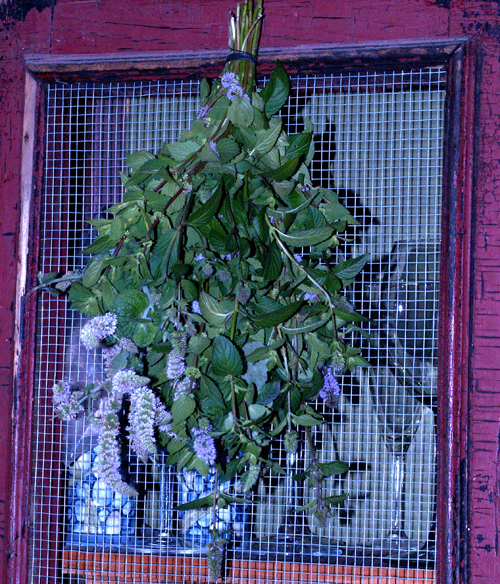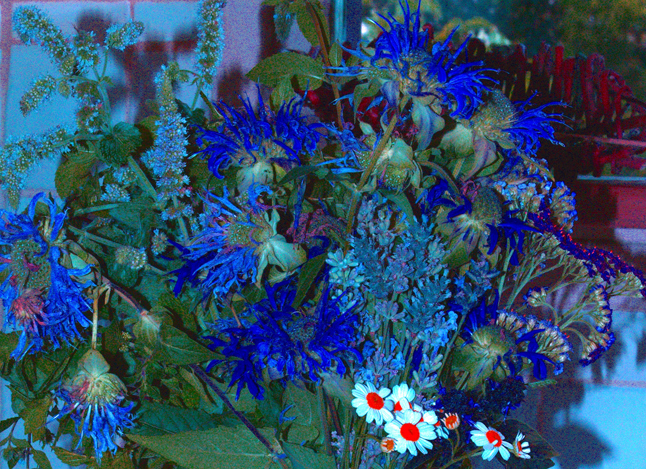

Few things match the satisfaction of growing and eating your own food. One of the easiest things to grow are herbs. They’re more likely to perish from pampering than neglect, are tolerant of a wide range of conditions, and prefer poorer soils. Some herbs actually benefit from being stepped on like thyme, mints and lemon balms, making them an excellent choice for walkways, paths and even lawns. In Revelstoke, most herbs don’t need winter protection and oblige our snowy yards by dying to the ground in winter. Rosemary, lemon grass, basil (an annual) and scented geraniums are exceptions
The term “herb” is used to describe over 4000 plants with as many as 12,000 varieties. Herbs have been in use, primarily for medicinal purposes, since time began, with earliest records of herbs used for culinary purposes are from 3700 BC.
Maybe because they started as wild things, most herbs actually are healthier and grow better if they are grown in crowded conditions and are harvested regularly, up to one third of the branch weekly. Herbs thrive in containers, and I always pot up a number or culinary herbs such as chives, oregano, mint, thyme and sage for winter indoor use. Parsley, due to its tap root, must be started in a pot.
Home-grown herbs give you an opportunity to try different combinations. We’ve come a long way
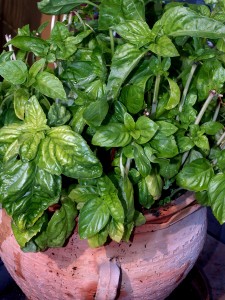
in our culinary style from the days of using sage only with turkey. Newer herbs such as lemon grass, savory and a stunning array of basil varieties spice up the dinner table at low cost when they’re there outside your back door. Just let your taste buds tell you what works. Cooking with fresh herbs is an experience in flavour.
Cut a few sprigs of your favourite herbs to use fresh in cooking veggies or meats, and even in desserts. The general rule when substituting fresh herbs for dried in a recipe is to use 2-1/2 times fresh. Add the fresh chopped herbs at the very end of cooking to preserve taste—you want that fresh garden look and taste, not a wilted stem or leaf of indistinguishable flavour.
At this time of the year, harvesting herbs often invokes drying. With the exception of basil, most herbs retain and intensify their flavour when dried. Most are very easy to dry and the only real requirement is a dark, well-ventilated, dry area.
To harvest herbs such as oregano, mint, sage, and dill, I choose a cloudy, dry morning and harvest these plants in fist-sized bundles. Cut the stem halfway down the branch and strip off the bottom 2 inches of leaves. Tie the bundles at the clean stem with a rubber band and hang flower end down to dry. For smaller plants such as thyme, bundles are awkward, so I dry thyme on window screens placed on cookie cooling racks to allow air flow and an even drying process. Fresh herbs can also be dried slowly if placed in a paper bag and put in the fridge.
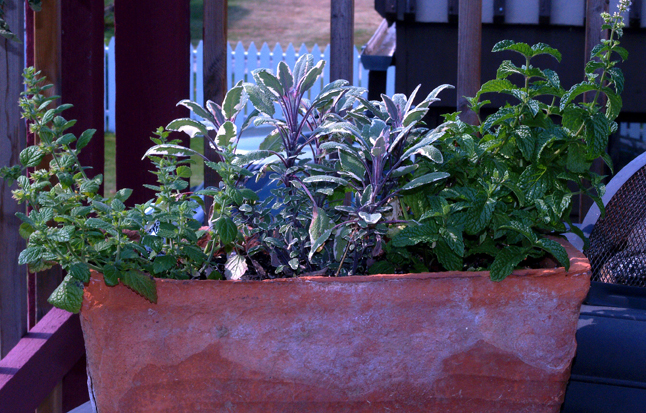
The prettiest way to dry herbs is to pick them as bouquets. Simply cut off the desired quantity of the needed herb with scissors. To keep the dried herbs bundles dust free during the winter, periodically use a blow drier to clean them off.
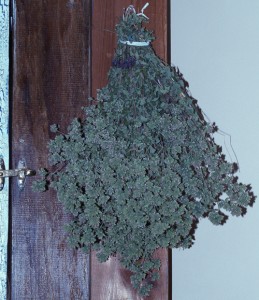
Basil is an enigma in the culinary herbal world—one of the few herbs that is an annual that grows, sets seed and dies in one season. Basil must be planted from seed every spring. Basil is also an intense flavour when fresh, but bland when dried. You can however preserve Basil—chop it into small pieces and freeze it, covered with water, in an ice cube tray. I often add a small quantity of olive oil to the basil prior to freezing. The other method of preserving basil is to make it into a pesto and then preserve it in jars. (See recipe below).
When drying herbs, you can create your own herbal blends—these are lovely to have in the winter, to evoke the memories of the summer garden. Once the herbs are thoroughly dried, starting at the clean stem end simply run you fingers along the stem to snap off the leaves. Discard the stems. Put the dried leaves in a ziplock bag and crush by squishing the bag. Or use a mortar and pestle. Crush finely but not into powder—retain a little texture.
Herbs can also be preserved by packing fresh bruised leaves into either vinegar or oil to make
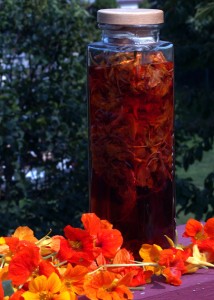
herbal marinades and vinaigrettes. These, when bottled are very beautiful. The temptation to store them on the windowsill is great, but a dark cupboard is a safer place to store them for 1-2 months they need for the flavours to infuse.
Sandra Davis is a local gardener. She graciously agreed to write this column for Leslie Savage while she is in Vancouver
